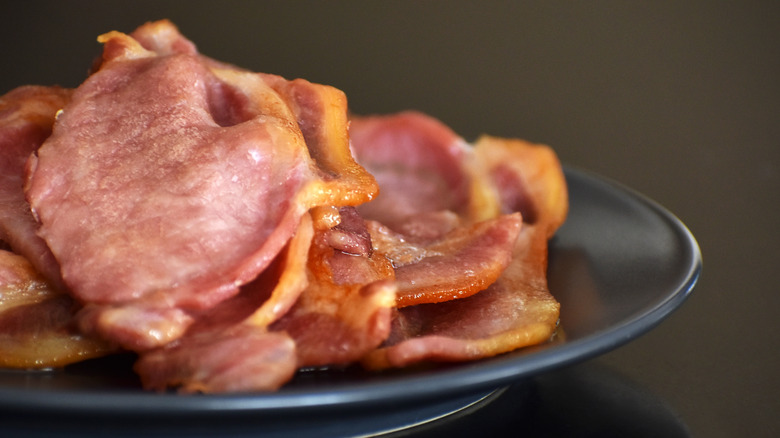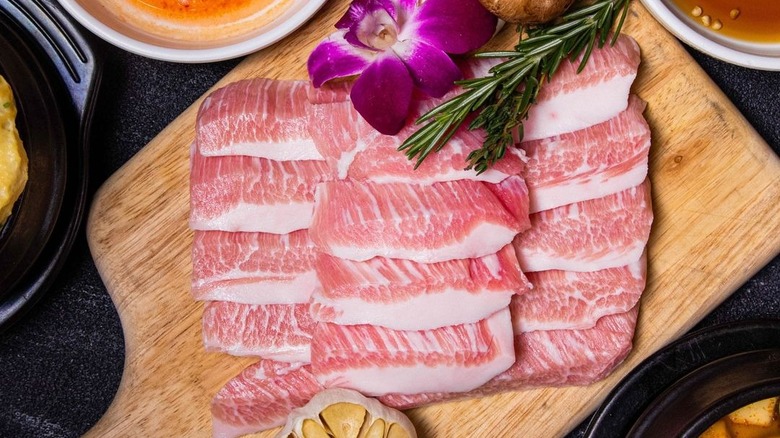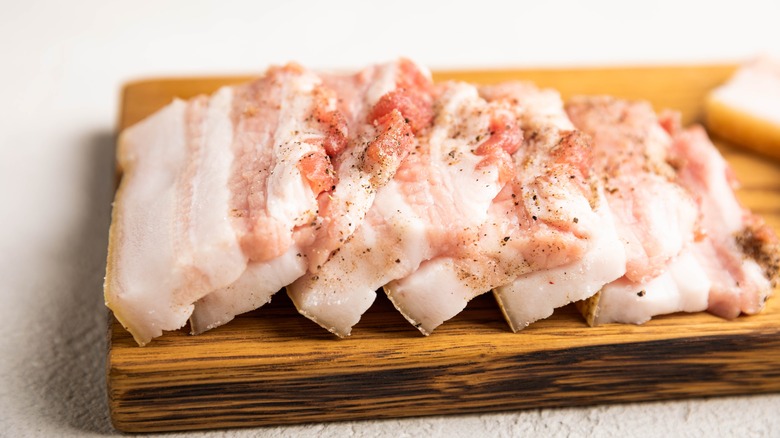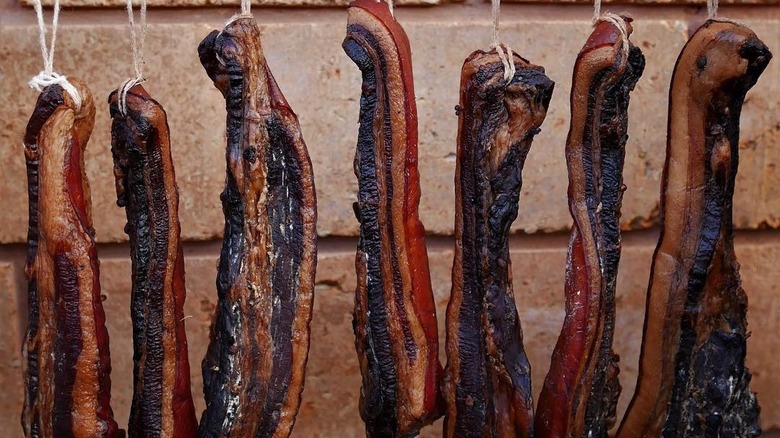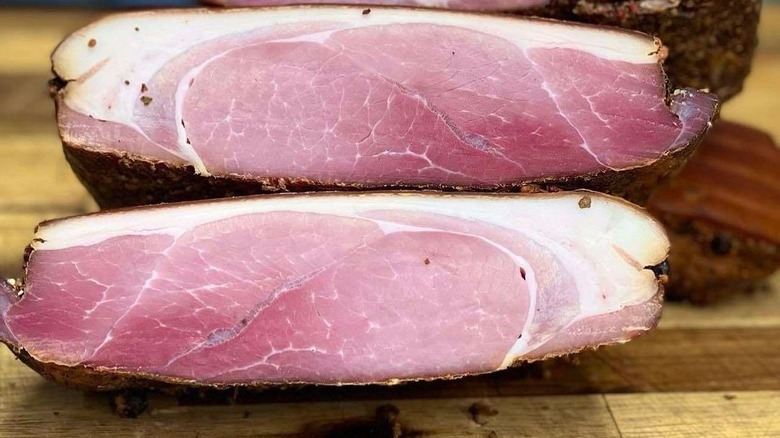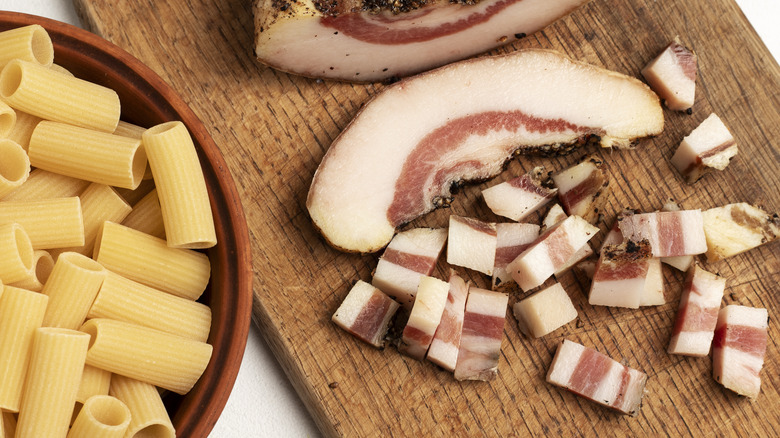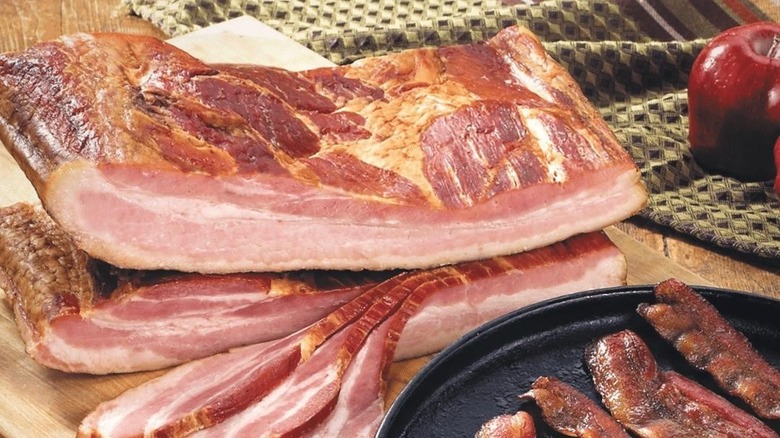14 Types Of Bacon And How To Use Each Of Them
From sandwiches and casseroles to salads and soups, almost everything is better with bacon. The ingredient, which is traditionally made with pork, boasts a smoky and salty umami flavor that's oh-so-satisfying. Most commonly, bacon is made with the belly of a pig, but did you know that other parts can be used, too? The result is different types of bacon that vary in flavor and texture. What's more, bacon can even be prepared using a variety of techniques, seasonings, and slicing methods. All of these factors impact the best way to incorporate each style into your favorite bacon recipes.
For example, fattier varieties are ideal for adding a rich texture to dishes. These versions work well when paired with foods of contrasting consistencies, such as fresh vegetables. They'll also release a lot of fat when cooked, which might be desirable if you enjoy cooking with bacon grease. Other versions are meaty and lean, making them perfect for adding bulk to dishes sans extra grease.
Regardless of the variety of bacon you're working with, it's important to safely handle the meat. Always store it in the refrigerator at 40 degrees Fahrenheit or cooler. Keep it away from raw foods, like raw meat or fish, especially if the bacon is sold ready-to-eat. Otherwise, the drippings from raw meat might contaminate the bacon, potentially spreading illness-causing germs. Even then, you'll want to check the handling instructions for your specific type of bacon, as different varieties might call for different storage methods.
American-style bacon
If you grew up in the U.S., this is the variety that likely comes to mind when you think of bacon. Made from pork belly, American-style bacon typically consists of fat and meat running parallel to each other, resulting in a streaky pattern. It's also salt-cured and smoked, which creates a delightful umami flavor that complements sweet and savory dishes alike.
There are many ways to use American-style bacon, which is great news if you love the ingredient. It can be served as a side dish, layered in sandwiches, or chopped and used as a topping for casseroles, pasta, and salad. However, the best method depends on its thickness. Thicker cuts are about 1⁄8 inch thick and take some time to cook, so they're ideal for recipes where bacon would quickly burn. For example, if you're wrapping bacon around an ingredient that requires a long cook time, buying thick-cut bacon means it's less likely to burn. Alternatively, thin-sliced and regular bacon are thinner, so they'll become crispier in a shorter timeframe. Use this type of American-style bacon when you want a crispy texture for sandwiches or a crunchy topping.
Canadian bacon
Canadian bacon is made from pork loin, which is the part between the shoulder and back legs of a pig. This area is low in fat, so it's much leaner than the pork belly used to make American-style bacon. However, in Canada, this variety of bacon is simply known as "bacon" or "back bacon." The name "Canadian bacon" is only used by Americans.
Although Canadian bacon can be used like American-style bacon, its shape makes it extra useful for certain dishes. It's typically sliced and sold in circles, making it perfect for neatly layering breakfast sandwiches made with English muffins, bagels, or other round breads. It's also a standard ingredient in eggs Benedict, an open-faced sandwich made with English muffins, poached eggs, and hollandaise sauce.
Another reason to use Canadian bacon is if you're looking for a healthier alternative to American-style bacon. It naturally contains less salt and fat, which means it's ideal if you want to reduce your intake of these nutrients. Additionally, if you want a savory meat but don't feel like cooking it, Canadian bacon is an excellent choice. It's cooked before it's sold, so you can eat it right out of the package, just as you would ham or bologna.
Peameal bacon
Peameal bacon is thought to hail from Toronto, Canada. It's similar to Canadian bacon, as it's also made with pork loin and leaner than American bacon. The main difference is that it's rolled in yellow cornmeal before it's sliced, so the edges have a yellow powdery crust. However, it used to be rolled crushed, dried peas, which is why it's called peameal bacon.
If you're looking for a slice of meat with less salt or fat than American-style bacon, go for peameal bacon. It's also a delicious choice if you want to add extra flavor to sandwiches, wraps, or grazing boards, as the cornmeal crust might include spices and seasonings, depending on the recipe or brand. Otherwise, peameal bacon is traditionally served at breakfast as a side dish or sandwich ingredient. Plus, it's mainly found in Canada, so it's an excellent addition if you're in the mood to sample Canadian foods you need to try at least once.
Rashers
Rasher is a style bacon made from the pork loin, so it's leaner than the American-style bacon made from pork belly. The term "rasher" is mainly used in the United Kingdom, where American-style bacon is known as "streaky" due to the streaks of fat and meat. Rashers are similar to Canadian bacon in that they're made with the same part of the pig, but they come in strips, just like the American kind.
As a classic British breakfast food, rashers are often used in "fry-ups" or British breakfast spreads. Most often, they're paired with pork sausages, known as bangers, along with beans, tomatoes, and eggs. Sometimes, the fry-up also includes potatoes, mushrooms, beef kidneys, kippers, and black or white pudding. Otherwise, rashers are a great alternative if you want the look of American-style bacon with less fat. Enjoy them in sandwiches, wraps, side dishes, or chopped and sprinkled on casseroles, pasta, and rice.
Cottage bacon
Cottage bacon, also known as buckboard bacon, is made from smoked pork shoulder (also known as pork butt) instead of pork belly. Since the shoulder contains less fat than the belly, the resulting bacon is leaner and meatier. Plus, the process of making cottage bacon involves smoking and curing. This means it doesn't need to be cooked before it's eaten, though you can certainly fry it if you'd like.
In terms of flavor, cottage bacon tastes like a mix between bacon and ham. This means you can use it just like you would either ingredient, whether you're making a sandwich or tossing chopped pieces in a salad. Additionally, since cottage bacon doesn't need to be cooked, it's an ideal meat for raw preparations such as grazing boards. Similarly, the tougher texture makes it a great candidate for bulking up recipes or adding a hearty side dish to breakfast as well.
Gypsy bacon
Gypsy bacon is a type of bacon with the rind. It's also known as zigeunerspeck and is eaten in Hungary. However, you can find it in German, Hungarian, or Polish delis. The cut used for gypsy bacon can also vary. For example, you can find versions made of pork belly and other versions made of pork loin. In either scenario, gypsy bacon is seasoned with paprika and smoke-cured, though it still needs to be cooked.
Traditionally, gypsy bacon is sliced and cooked over a fire on a stick, making it an excellent food to serve at your next bonfire. Once the gypsy bacon is fully cooked, hold it over vegetables; the drippings will add a significant amount of flavor. You can then serve the bacon with rye bread, red onions, and baked beans for a hearty sandwich. Otherwise, consider the smoky yet sweet taste of paprika when using this variety of bacon in your own dishes. Use it to upgrade simpler or plain dishes that need an extra little something.
Jowl bacon
If you love standard bacon but want to try something new, consider jowl bacon, also known as pork jowl. This type of bacon is made of pig cheek that has been smoked and cured, just like bacon made of belly. The cheek is also fatty like the belly, so the resulting bacon has a similar flavor and texture as regular bacon. The main difference is that jowl bacon comes with the rind and skin, offering even more tasty elements to the meat.
You can use jowl bacon in any dish that would typically call for pork belly, such as sandwiches, steamed buns, and tacos. It also serves as a rich topping for meals like ramen and potato hash. Additionally, as this type of bacon boasts a taste and consistency similar to regular bacon, it can be used just like the latter — with beans, peas, collard greens, or your go-to rice dish. The decadent texture of jowl bacon is particularly helpful for balancing the crispy, fresh textures of foods like coleslaw and salads. Also, as jowl bacon is so fatty, it will produce a lot of grease once cooked. Use this bacon grease to upgrade the flavor of other dishes to upgrade the flavor of other dishes, such as eggs, gravy, or fried rice.
Salo
Salo is a type of bacon that plays an important role in Ukrainian cuisine. The bacon is almost made entirely of the back fat of a pig, so it has a creamy color and buttery consistency. The exact process for making salo varies, but it can be brined, smoked, or dried. The latter method is the most common, resulting in an ingredient that can be enjoyed raw.
Traditionally, salo is sliced thin and eaten as a snack. It's typically paired with rye bread, garlic, cucumber, and onions. Additionally, if you love sour soups, you'll want to add salo to your shopping list. The fatty bacon is a standard ingredient in borshch, a sour soup served in Ukraine. Other traditional uses for salo include frying it to make shkvarky, a type of crispy pork rind, or adding it as a topping for vegetable dishes. Try it with crunchy options, like green beans or lettuce, which complement the creaminess of the bacon.
Samgyeopsal
A Korean style of bacon, samgyeopsal is made of pork belly, just like American bacon. The key difference is in the preparation, as samgyeopsal is not cured. The word "samgyeopsal" means "three-layered pork" in Korean, which is a nod to the strips of meat and fat in the belly. The meat is also usually served as a grilled dish, or "gui" in Korean. As a result, you might find it referred to as "samgyeopsal-gui."
If you enjoy Korean BBQ or hot pot, you'll appreciate the flavors that samgyeopsal can add to the meal. Typically, it's served grilled with Korean BBQ sauce or traditional Korean sides, such as kimchi. It also pairs beautifully with lettuce and other fresh vegetables, which offer a satisfying contrast to the rich and creamy texture of pork belly. However, you're not limited to entrees, as chunks of grilled samgyeopsal can be served on individual toothpicks for a hearty party appetizer.
Lap yuk
Lap yuk is a type of Chinese bacon made of pork belly, just like American-style bacon. It can also be made from the shoulder, which is leaner and meatier than the belly. In either case, lap yuk often has the rind, adding extra flavor and texture. The process for making Chinese bacon involves air-curing pork belly with soy sauce, brown sugar, and warming spices such as cloves, star anise, and cinnamon. It can also be cured for a short time and then smoked.
You can buy Chinese bacon at specialty Asian grocery stores. Once you've acquired the meat, you might notice that it's very hard; you'll need to soak it in water to tenderize it first. From there, toss it in your rice cooker the next time you make a batch of rice. When the rice is done cooking, the Chinese bacon will be soft and ready to enjoy. Otherwise, lap yuk can be served in stir-fries or fried rice for a meaty, savory element.
Speck
Speck is a German bacon also known as durchwachsener speck, fetter speck, or simply bacon. It's made of pork belly and cured with salt like American bacon, but it's also smoked with beechwood and air-dried. The beechwood gives speck a unique smoky flavor and smell. It can be enjoyed raw or cooked, making it a versatile bacon to work with.
There are many ways to use speck in your dishes. Raw speck is a common appetizer, making it an excellent candidate for your next charcuterie board. The smokiness of the meat will pair beautifully with tangy cheese and sweet dried fruits. If you're looking for an appetizer that's easy to split and share, try spearing chunks of cheese and pieces of speck on toothpicks. Also, if you're slicing it yourself, be sure to cut speck into thin slices. This will allow you to fold and arrange the meat in a way that's visually appealing.
Pancetta
Pancetta is an Italian-style bacon made of pork belly. It has both lean meat and fat, but unlike regular bacon, it's not smoked. Instead, it's salt-cured and seasoned with pungent spices, such as peppercorns, fennel, and nutmeg. The curing process can take several months, after which the meat is rolled and thinly sliced. You can also find pancetta in slabs, which can be chopped and used in various dishes.
The best uses for pancetta depend on its form. Thinly sliced pancetta can be cooked in a frying pan, which will make it crispy like American-style bacon. Be sure to fry the pancetta over low heat, as its thin texture will make it cook quickly. Pancetta is also safe to eat raw, so it can be added to charcuterie boards alongside cheese, nuts, and fruits. When chopped into cubes, pancetta can be swapped for guanciale in spaghetti carbonara, a classic Italian pasta dish made with a creamy egg and Parmesan sauce.
Guanciale
Another Italian-style variety, guanciale is different from American bacon in that it's made from pork cheek. However, it's different from normal jowl bacon as it's not smoked. Instead, it's coated with spices like salt and ground black pepper, plus seasonings like chili pepper, garlic, sage, and rosemary, depending on the region. The meat is then aged for three months or longer, making the texture harder than pancetta and American-style bacon.
Guanciale, like pancetta, can be eaten raw or cooked. A little goes a long way with guanciale, as the meat is rich in spices but often cut into thin pieces. This makes it ideal for upgrading lighter sandwiches and salads, as it will add flavor without bulking up the dish. Raw guanciale is a common component of charcuterie boards, while the cooked version is a popular addition to pasta, sauces, and vegetables as a salty and flavorful wrapper. Note that quality guanciale isn't cheap, so consider saving the meat for special occasions and celebrations.
Slab bacon
Slab bacon is essentially uncut American bacon, meaning it's also made of cured and smoked pork belly. It still has the rind and it's sold in the form of a block or slab. When sliced, the pieces are what we know as bacon. You can find it at butcher shops, where it's cut according to the customer's request, though it's often possible to purchase the entire slab, too.
If you frequently use bacon in dishes, buying slab bacon is worth it. The benefit is that you can prepare the meat in multiple ways, depending on how you plan to use the ingredient. For instance, with a single block, you can create cubes or finely chopped pieces of bacon to mix into salads, pasta, casseroles, or rice. If you want thick slices for wrapping and roasting vegetables, cut the slab into thicker pieces. For a crispy crumbled topping or sandwich component, cut it into thinner slices.




